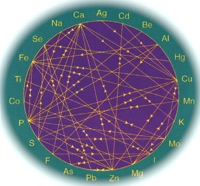Difference between revisions of "Mineral"
(Created page with 'File:lighterstill.jpgright|frame ==Origin== [http://nordan.daynal.org/wiki/index.php?title=English#ca._1100-1500_.09THE_MIDDLE_ENGLISH_PERIOD Mid...') |
m (Text replacement - "http://" to "https://") |
||
| (One intermediate revision by the same user not shown) | |||
| Line 2: | Line 2: | ||
==Origin== | ==Origin== | ||
| − | [ | + | [https://nordan.daynal.org/wiki/index.php?title=English#ca._1100-1500_.09THE_MIDDLE_ENGLISH_PERIOD Middle English], from Medieval Latin minerale, from neuter of mineralis |
| − | *[ | + | *[https://en.wikipedia.org/wiki/15th_century 15th Century] |
==Definitions== | ==Definitions== | ||
*1: ore | *1: ore | ||
| Line 13: | Line 13: | ||
*6: plural British : mineral [[water]] | *6: plural British : mineral [[water]] | ||
==Description== | ==Description== | ||
| − | A '''mineral''' is a naturally occurring solid [[chemical]] substance that is formed through [[geological]] [[processes]] and that has a characteristic chemical [[composition]], a highly ordered [[atomic]] [[structure]], and specific physical properties. By [[comparison]], a rock is an aggregate of minerals and/or [ | + | A '''mineral''' is a naturally occurring solid [[chemical]] substance that is formed through [[geological]] [[processes]] and that has a characteristic chemical [[composition]], a highly ordered [[atomic]] [[structure]], and specific physical properties. By [[comparison]], a rock is an aggregate of minerals and/or [https://en.wikipedia.org/wiki/Mineraloid mineraloids] and does not have a specific chemical composition. Minerals range in [[composition]] from [[pure]] [[elements]] and simple [https://en.wikipedia.org/wiki/Salt salts] to very [[complex]] silicates with thousands of known forms. The study of minerals is called [https://en.wikipedia.org/wiki/Mineralogy mineralogy]. |
| − | To be [[classified]] as a true mineral, a substance must be a [[solid]] and have a [[crystalline]] [[structure]]. It must also be a naturally occurring, [[homogeneous]] substance with a defined chemical composition. [[Traditional]] definitions excluded organically derived [[material]]. However, the [ | + | To be [[classified]] as a true mineral, a substance must be a [[solid]] and have a [[crystalline]] [[structure]]. It must also be a naturally occurring, [[homogeneous]] substance with a defined chemical composition. [[Traditional]] definitions excluded organically derived [[material]]. However, the [https://en.wikipedia.org/wiki/International_Mineralogical_Association International Mineralogical Association] in 1995 adopted a new definition: |
:a mineral is an [[element]] or [[chemical]] compound that is [[normally]] [[crystalline]] and that has been formed as a result of [[geological]] [[processes]]. | :a mineral is an [[element]] or [[chemical]] compound that is [[normally]] [[crystalline]] and that has been formed as a result of [[geological]] [[processes]]. | ||
| − | The [[modern]] classifications include an organic class – in both the new Dana and the [ | + | The [[modern]] classifications include an organic class – in both the new Dana and the [https://en.wikipedia.org/wiki/Strunz_classification Strunz classification] schemes.[https://en.wikipedia.org/wiki/Mineral] |
[[Category: Chemistry]] | [[Category: Chemistry]] | ||
Latest revision as of 01:22, 13 December 2020
Origin
Middle English, from Medieval Latin minerale, from neuter of mineralis
Definitions
- 1: ore
- 2: an inorganic substance (as in the ash of calcined tissue)
- 3: obsolete : mine
- 4: something neither animal nor vegetable
- 5:a : a solid homogeneous crystalline chemical element or compound that results from the inorganic processes of nature; broadly : any of various naturally occurring homogeneous substances (as stone, coal, salt, sulfur, sand, petroleum, water, or natural gas) obtained usually from the ground
- b : a synthetic substance having the chemical composition and crystalline form and properties of a naturally occurring mineral
- 6: plural British : mineral water
Description
A mineral is a naturally occurring solid chemical substance that is formed through geological processes and that has a characteristic chemical composition, a highly ordered atomic structure, and specific physical properties. By comparison, a rock is an aggregate of minerals and/or mineraloids and does not have a specific chemical composition. Minerals range in composition from pure elements and simple salts to very complex silicates with thousands of known forms. The study of minerals is called mineralogy.
To be classified as a true mineral, a substance must be a solid and have a crystalline structure. It must also be a naturally occurring, homogeneous substance with a defined chemical composition. Traditional definitions excluded organically derived material. However, the International Mineralogical Association in 1995 adopted a new definition:
- a mineral is an element or chemical compound that is normally crystalline and that has been formed as a result of geological processes.
The modern classifications include an organic class – in both the new Dana and the Strunz classification schemes.[1]
